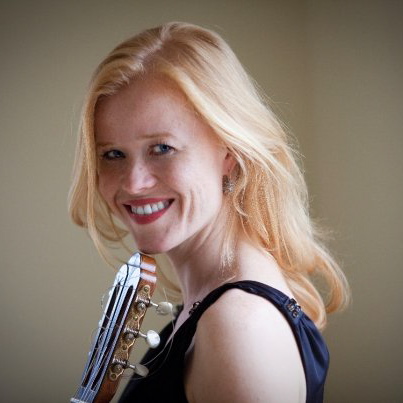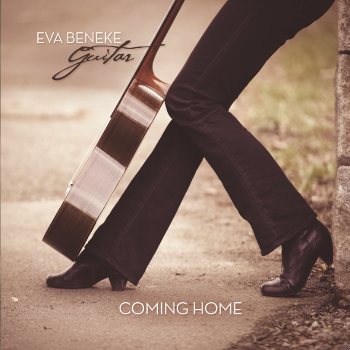
Fine Classical, Instrumental, and Specialty Recordings
Label: Eva Beneke Item Number: EB-001 Format: CD Year Recorded: 2010 Coming Home Eva Beneke
Eva Beneke - guitar  A native of East-Berlin, Eva Beneke first wanted to be a pianist - but her family could not afford the instrument and she picked up one her father's and grandfathers many classical guitars. Eva Beneke is an exciting and versatile musician. She is an internationally acclaimed soloist, chamber musician, teacher and arranger, known for "refinement of tone, and a palpable energy" (Scott Tennant, L.A.G.Q.). In addition to numerous prizes at international guitar festivals Eva Beneke is an unstoppable performer. Highlights of her career include appearances with the German Symphony Orchestra under Kent Nagano, invitations to international festivals in Perú, Germany, Lithuania, the U.S. and Canada and a live performance with Carrie Underwood at the 2010 American Country Music Awards. Eva Beneke's debut CD, Coming Home, was released to wide critical acclaim in 2010. Her performances have been broadcasted internationally. Beneke's arrangements for guitar ensemble are gaining international recognition. The American publishing-house Clearnote Music published two of her guitar compositions in 2009. Eva Beneke began her studies at the Berlin University of Arts with Martin Rennert. She then received the prestigious solo artist diploma at the Franz Liszt Hochschule in Weimar where she trained extensively with Thomas Müller-Pering, one of Germany's most influential guitarists. In 2012, Beneke received a doctorate with honors from the University of Southern California in Los Angeles, after having studied with Grammy winning guitarist Scott Tennant and jazz-guitar legend Bruce Forman. Starting September 2012, Eva is honored to join the renowned faculty at McNallySmith College of Music in St. Paul, MS. Here she will be the only full-time classical guitar faculty. J.S. Bach - Suite No. 6 in D major, BWV 1012 (6 Suiten fur Violoncello Solo) The Six Suites for Unaccompanied Cello belong to the famous repertoire for solo-instrument that Bach gave to the world along with the six sonatas and partitas for violin solo, the seven works for lute and the suite for solo-flute. With their unique musical language, the cello-suites fit the guitar particularly well. Composed between 1717 and 1723 (most likely prior to the violin sonatas and partitas) scholars around 1900 believed the suites to be études. In 1889, 13-year old Pablo Casals found the music in a thrift shop in Barcelona, Spain. After a period of intense study, he went on to publicly perform all of the suites, becoming a pioneer to the performance of Bach's work. It was not until 1925, at the age of 48, that he become the first to record all six suites. Their popularity subsequently soared, and Casal's original recording is still widely available today. The history of transcribing and arranging the suites started from the very beginning. Since no autographed manuscript survived, secondary sources, like the hand-written copy by Bach's second wife, Anna-Magdalena, serve as "authentic sources" - causing a variety of interpretations. Recent speculations even attribute the suites entirely to her (Prof. Martin Jarvis, Charles Darwin University Australia, see also cbc-news article & Deutscher Tonkunstlerverein) along with the Goldberg Variations (BWV 988) and the first book of Das Wohltemperierte Clavier (BWV 846-893). Attempts to compose piano accompaniments for the suites include a notable effort by Robert Schumann. In 1923, the Polish-American pianist and composer Leopold Godowsky realized suites 2, 3 and 5 in full counterpoint for solo piano. The suites have been transcribed for numerous instruments, including marimba, mandolin and saxophone. Andrés Segovia was the first classical guitarist to include single movements, such as the Gavottes of the 6th suite, or the Prelude of the 1st (in G-Major) in his recitals. Bach himself did not specify any intended instrument at all, and we know that the early 18th-century musician loved to construct and play new, unusual instruments. Anna Magdalena Bach's manuscript is the only of three sources to indicate the tunings of the strings and informs the player that the suite is intended for an instrument "a cinq cordes"- very likely the five-stringed violoncello piccolo with the highest string tuned to E. My transcription attempts to demonstrate the suitability for the guitar as a 6-string instrument. Certain effects I found to be very idiomatic to the guitar, like the unusual use of arpeggios, numerous runs and cross-string phrasings in the Prelude. Others remain challenging: how to replicate the sonority and vocal qualities of the slower movements, Allemande and Sarabande? Again, I rely on the guitar: campanella-fingerings, phrasing and fingering-decisions that support the instrument's natural harmonics and an occasionally added or replaced bass-note in the octave below the original to produce more overtones are the only changes I made to Anna Magdalena's autograph. The fast movements Courante, Prelude, Gigue are exactly how Bach has written them, with the exception of a few cadenza-chords that have been filled out. My transcription remains a work in progress, and if you hear me play it in concert, you might find that it has evolved and changed. Isn't that the nature of all music, be it modern or ancient, and certainly true for any transcription? Mstislav Rostropovich called the 6th suite "a symphony for solo cello" and characterized its D-Major tonality as evoking joy and triumph, certainly best expressed in the Prelude with its unusually virtuosic cadenza. For Bach, the suites offer a playground to explore the margins of the traditional baroque Suite. He inserts the popular Galanteries (Gavottes, Minuetts or Bourées) between the older dances Allemande, Courante, Sarabande and Gigue and adds a quasi improvisatory Prelude. Symmetrically composed, the suites are of six movements each and seem to incorporate a certain character within each suite. (Daniel Melamed) As the longest, the Sixth Suite marks the musical stepping-stone into the age of the soloist, contemplation and virtuosity in one instrument. Eva Beneke (Los Angeles, June 2010) Carlo Domeniconi - Chaconne fur Gitarre* Carlo Domeniconi was born in Cesena, Italy in 1947, and lives in Berlin, Germany. He studied guitar and composition and taught at conservatories in both Berlin and Istanbul. Domeniconi is mostly know for his highly distinctive idiom and personal style, owed to his familiarity with Indian, Turkish and Arabian musical forms and tonal systems. His pieces for solo instruments, chamber music and orchestra are being played throughout the world. The composer about his Chaconne: "There is no doubt that the Chaconne of all Bach's pieces is best suited to the guitar. However, it is transcribed in a way which is either 'puristically' dry (to the detriment of the guitar) or romanticized, virtually in the style of Busoni, to the detriment then of Bach... This piece is in no way intended as an alternative. As with all my compositions it arose from the need to create a new piece of music for the guitar. 'My' Chaconne consists essentially of the same rhythms, the same harmony and the same number of variations as that of Bach. It is, so to speak the Bach Chaconne with different notes. This composition does not fit into any particular 'box' and I am sure that some musicians will like it ..., and others will not." Carlo Domeniconi (Berlin, September 2004) published with edition ex tempore, Berlin 2005 Eva Beneke - Three pieces for guitar. Stormy crossing owes its title to the description of a ferry-ride across the English channel, with high waves, sunny episodes, and a strong wind blowing throughout. The piece is written under the influence of matters of the heart, which can indeed be turbulent! Say it again* "Joy de vivre" and its opponent, "worry" in a cascade of sixteenth notes. Joy wins! Coming home* is written for my dad and for everyone who knows the feelings of returning to the familiar, beloved and challenging place that is home. * published with Clear Note Publications, Ohio 2009, Catalogue Number 74434 Eva Beneke - October 2009
Label: Eva Beneke Item Number: EB-001 Format: CD Year Recorded: 2010 A stunning classical debut-album ...original repertoire and rare transcriptions, mature interpretation and powerful, emotional playing. "Dear Eva. I enjoyed so much your new cd recording. Your transcriptions and performances of Bach's magnificent music are presented as if Bach had written them for the guitar. Beautiful recording. Bravo. Pepe Romero" October 18, 2010 "There are not many CDs which come my way for review where, once the review has been written, the disc gets played again, it just gets put in the record collection with hundreds of others. I think COMING HOME will be different ... it earns a place on my 'special' shelf which contains all the recordings which stand out from the rest and get played time and time again." Steve Marsh, UK magazine Classical Guitar Review (Sept. 15 2010) www.stevemarsh.uk.com "I thoroughly enjoyed listening to Eva Beneke's new cd 'Coming Home'. She plays her guitar with technical assurance, a refinement of tone, and a palpable energy that conveys a sincere emotional involvement in what she is playing. I look forward to more." Scott Tennant, Grammy-Award winning guitarist (August 2010) | |||||||||||||||||||||||||||||||||||||||||||||||||||||||||||||||

 Amazon
Amazon Follow Us on Twitter
Follow Us on Twitter Follow Us on Instagram
Follow Us on Instagram Visit Our Partner Soundset Recordings
Visit Our Partner Soundset Recordings